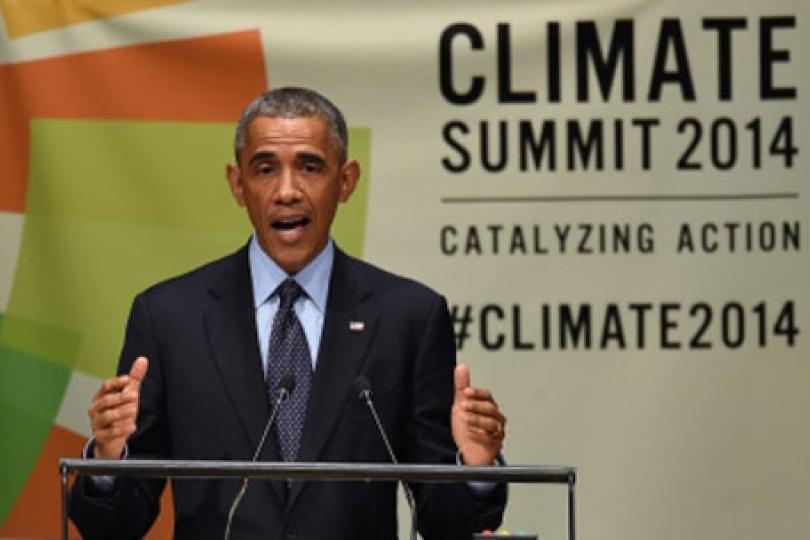Public Ire and Impatience With Washington Climate Gridlock Underlie Massive Climate Demonstrations
(c) 2014 By John. J. Berger, Ph.D.
Berkeley, CA, September 21--What is the real meaning of the thousands of climate demonstrations around the world this week in over 150 countries plus the national outpouring of support for the People's Climate March? What does it portend for President Obama and mainstream party politicians?
Clearly a global grassroots climate change movement has finally come of age and is beginning to flex its muscles on the world stage. The concerted protests are sending the Obama Administration and world leaders a powerful message ahead of the UN Global Climate Summit on Tuesday, when heads of state from some 120 countries will grapple yet again with the ever-worsening global climate crisis.
By mounting the largest coordinated climate demonstration in world history in the wake of National Climate Week, the worldwide grassroots protest movement is finally demanding meaningful action on the epochal global climate crisis.
Previous global climate negotiations have all failed to set mandatory carbon emission cuts even as global emissions have climbed inexorably. The international community has thus had to accept voluntary commitments since the failed 2009 UN Climate Action Conference in Copenhagen. The US’s failure to embrace mandatory international reductions in greenhouse gases has made us part of the problem rather than the solution.
Voluntary greenhouse gas reduction pledges made at subsequent UN Climate Action Conferences in Cancun, Durban, and Doha, however, have been declared inadequate by the parties themselves to prevent an unacceptable rise in global temperature of 2°C or more.
Frustrated now with decades of ineffectual international negotiating under the auspices of the UN Framework Convention on Climate Change, the climate marchers and their millions of supporters are finally calling for an end to further procrastination now that global concentrations of greenhouse gases have soared to levels unknown on the planet for 5 million years.
The climate demonstrators are likewise making their frustration clear over Congress's failure to adopt a national cap 'n trade or carbon fee system or a national renewable energy requirement. President Obama's energy and climate policies, too, are in the crosshairs.
While laudably advancing energy conservation and renewable energy, the Obama Administration has gone full speed ahead with fossil fuel development as part of the President's self-described 'all of the above' energy policy.
The groundswell of support for Sunday's national Climate March is a clear indication that millions of Americans are finally fed up both with the Congressional stalemate over climate legislation and with the Federal government's fundamentally ineffectual, contradictory climate policies.
They see the President piously jaw-boning about the need for action to protect the climate while his Administration is busily throwing millions of acres of public lands open to oil, gas and coal producers even as the State Department promotes fracking abroad.
We will one day come to regret brashly disseminating this harmful technology just as we should rue the post-World War II Federal program that spread nuclear power technology around the world in the name of commercializing nuclear reactors, only to multiply the risks of nuclear weapons proliferation--much to our consternation today.
While the President has repeatedly called the nation's attention to the need for climate protection, his Administration has all the while wholeheartedly supported the fossil fuel industry's drilling agenda, whether on Federal land or in the Gulf of Mexico and the Arctic.
It is not clear how the Administration's efforts to dramatically increase U.S. fossil fuel production can be reconciled with his statements on the urgency of protecting the climate. Maximizing oil and gas and coal production is wholly inconsistent with climate protection, as is export of fossil fuels so others can burn it. But under the Obama Administration, the US has become the world's largest producer of natural gas and the largest producer of oil and gas in the world.
President Obama did not make climate change a major priority in his first term, but in his second he did put forward a Climate Action Plan in 2013 and sought to address climate with initiatives on energy efficiency, renewable energy, restrictions on power plant emissions, and an emphasis on the need to adapt to a changing climate.
Earlier this year, his Administration with some fanfare released its Third National Climate Assessment, which underscores the gravity of climate change impacts and prospects in the U.S. The President took to the airwaves to publicize and defend these findings. But the Administration has dragged its feet on international climate negotiations since 2009. The nation deserves a more ambitious, not to mention consistent, leadership from the President. His greenhouse gas reduction targets, for example--17 percent lower emissions in 2020 than 2005--are far less ambitious than the European Union's and its member states' goals.
The new Climate Assessment makes clear that even at the level of current global warming—less than 1° C—the impacts are already costly, dangerous, and growing worse. Climate and weather disasters cost the US some $100 billion in 2012, and the frequency and intensity of drought, floods, and wildfires have all increased. The West Antarctic Ice Sheet has already begun collapsing, which will eventually raise sea level by 4 - 12 feet, inundating major US cities where millions of Americans and others now live.
Nonetheless, global climate negotiations are aimed at keeping the world's fever to 2° C, which international negotiators are treating as a global climate safety limit, and the Obama Administration appears to be publicly acquiescing in this travesty. In my new book, Climate Peril, I demonstrate, that 2° C is demonstrably unsafe. "It would be about two and a half times the warming that the Earth has already experienced since preindustrial times. Rather than a safety limit, it is a nebulous transition zone between highly dangerous and extremely dangerous climate change."
In Climate Peril, I also explain how unlikely it is for us to keep the Earth from exceeding a rise of 2° C, given current emissions trends and the excess heat already stored in the ocean, which will ultimately drive the Earth's temperature up by at least 1-2° degrees F, and possibly more.
Climate change is already a planetary crisis that, if unchecked, will undermine our health, our economy, our environment, and our food supplies. Now that people are beginning to go into the streets to express their outrage at inaction about it, perhaps politicians will catch on. Even if oblivious to the gathering climate emergency, they cannot long remain indifferent to constituents willing to vote them out of office for condoning climate science denial and the do-nothing climate policies it was crafted to foster.
Hopefully the emergence of an empowered citizens climate protection movement will hasten the achievement of an effective, enforceable global climate agreement and tough US climate protection legislation.
John J. Berger, PhD. (www.johnjberger.com) is an energy and environmental policy specialist who has produced ten books on climate, energy, and natural resource topics. He is the author of Climate Peril: The Intelligent Reader's Guide to Understanding the Climate Crisis and Climate Myths: The Campaign Against Climate Science.
Additional Resources
Read an excerpt from Berger's newest book, Climate Peril: The Intelligent Reader's Guide to Understanding the Climate Crisis
Read Berger's Huffington Post two-part series:
Part I: "Rockets Red Glare Distract Nation From UN Climate Summit and Import of Global Climate Protests"
Part II: "Rocket's Red Glare, Bombs Bursting in Air Steal Global Climate Protests' Thunder"

